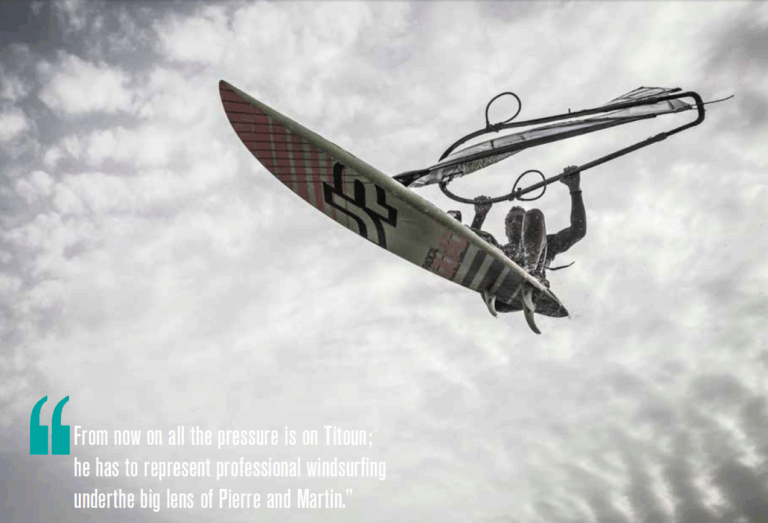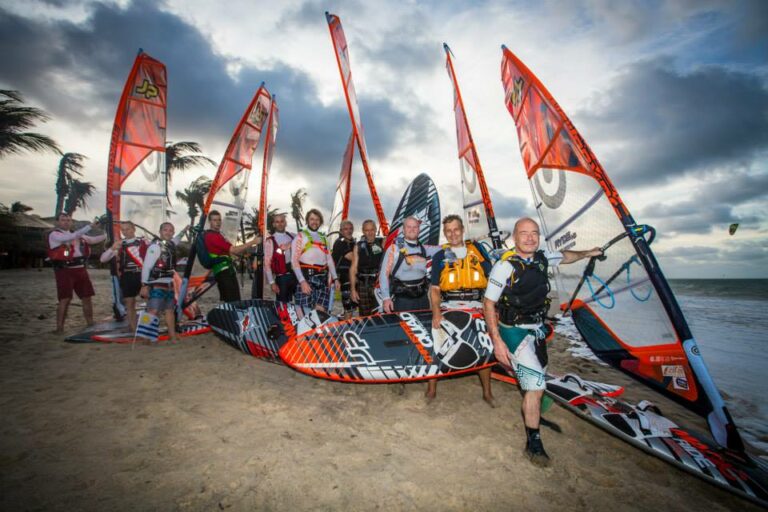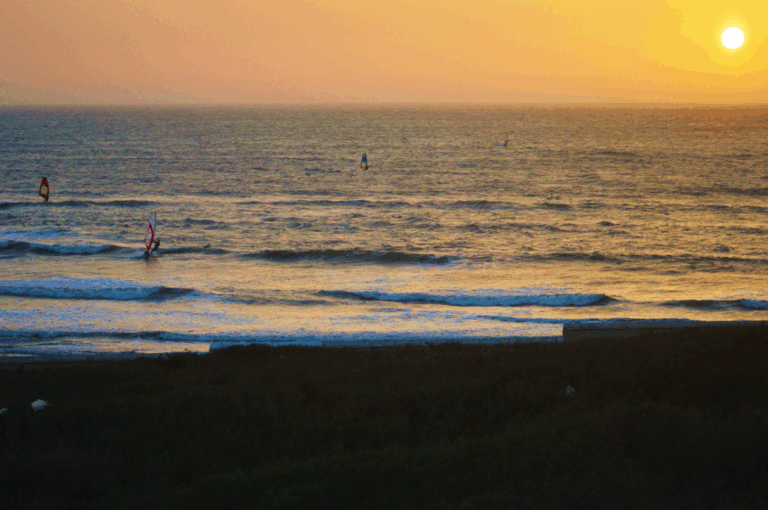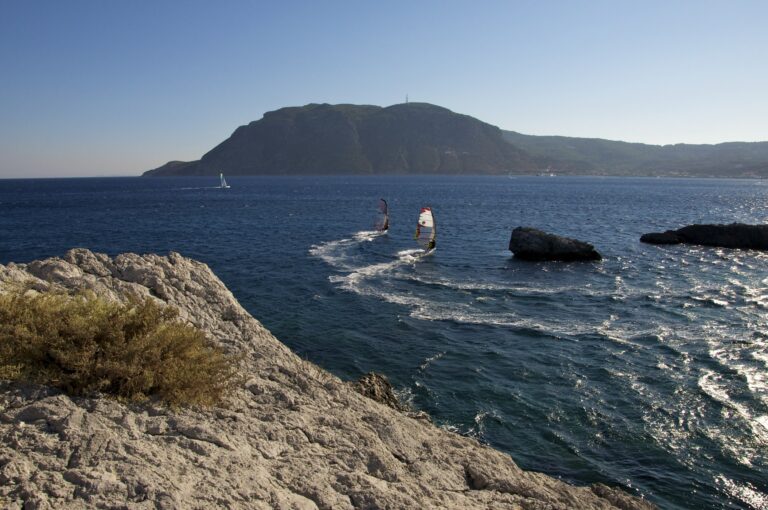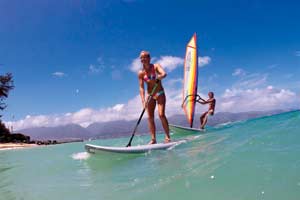Vietnam, in South East Asia is on the same peninsula as Thailand. It is a bustling, busy country and incredibly interesting. It is a communist state but a lot more market-focused than Cuba. The population are hugely industrious and friendly. Some of them speak English.
The PWA recently held a Freestyle competition in Mui Ne, 220Km east of Saigon in the South East of Vietnam. The wind there has a deservedly good reputation!
Fact File
| Windy Season | November – April, windiest in December and January |
|---|---|
| Water Temp In Summer | Warm! |
| Air Temp In Summer | tropical – 25°C |
| Wet Suit? | Boardies / Rash Vest |
| Average Wind Speed | Cross-on from left. Strong (up to 40 knots) and very consistent. Builds through morning and blows until sunset |
| Flight Time (From UK) | 12 hours from London to Singapore, 3 hour flight to Saigon. Direct flights from UK from 2012. |
- How To Get There
-
Flights
It is a fairly long trek from the UK. A 12 hour flight to Singapore, then three hour flight to Saigon. We flew Singapore Airlines and booked our luggage straight through. They give a great service on board – good seats for economy, great food and all the (now standard) movies and games.
On the outbound trip, we paid no excess baggage but it was $250 on the way back!
Other airlines include Malaysian, Cathay Pacific and Vietnam. In 2012 a direct UK flight is starting.
Visa
You need:
- 1. A passport sized photo of yourself; and
- 2. $25 payable on arrival in Vietnam.
If you don’t remember a passport photo, don’t worry it costs $5 in the airport.
Transfer
The transfer to the resort is 5 hours by car/small bus from Saigon to Mui Ne. Be prepared for this – can be tiring at the end of what already is a long journey. Although it’s only 200km, the state of the roads and speed limits mean that you can’t get there quicker.
Sportif are able to provide a week’s package including return flights, all transfers and 4* hotel accommodation right on the spot from £945pp.
For more information tel 01273 844919. www.sportif.travel
- How The Wind Works
-
The best and most typical wind direction blows cross-shore (ever so slightly onshore).
The wind builds through the morning and generally has an extra kick in the early afternoon. It continues to blow to sunset.
It is very steady, strong wind and ideal for intermediate and advanced sailors. There are also lessons available for beginners in the slightly flatter water upwind.
- The Sailing Spots
-
Hom Ron Beach (The Cemetery)
This is an onshore wave spot to the east of Mui Ne. Waves can get pretty big when the wind is strong.
The Waves are smaller towards the North end of the beach.
Suoi Nuoc
This is a full-on onshore beach where the waves can reach mast-high in strong winds.
- Water State
-
The water is pretty choppy with wind-blown swell but also very warm – only boardies and rash vest needed!
There is a shore-dump as the water gets deep straight off the beach. There is only a small tide that doesn’t seem to have much effect on conditions.
Although we didn’t see it, apparently the shore break becomes ride-able as it gets bigger with the phases of the moon. The waves break onto a 50m, rock free, sandy beach
- Instruction And Kit Hire
-
Windchimes, on the grounds of the Saigon Mui Ne Hotel, is a great place to chill out and has free WIFI and drinking water! They have a rental fleet of 50 Naish boards from 75 litre to 230 litre and 80 Neil Pryde sails from 4.0 to 7.6m.
They also offer kit storage if you bring your own and they charge $12 per rescue, if needed.
The instruction was great, but communication was not brilliant as the instructor didn’t speak much English. The instructors are very good sailors, so it is easy to watch and copy. They understand what you need to do in order to improve and are very helpful.
The owner of the centre is American Vietnamese, incredibly friendly and helpful and will also help with hotels, transfers, restaurant recommendations etc.
- Accommodation
-
We stayed in Saigon Mui Ne Resort which is stunning and right on the beach. It is set in beautiful tropical gardens, shaded by swaying palms and has a very big private beach. We transferred to a beach-front room after initially being near the yard – highly recommended!
For those on a tighter budget, you can find a great thatched bungalow for $15-20 per night – true paradise!
- Food
-
The food is utterly fantastic and very cheap. It is difficult to spend more than £4 for dinner and drinks! In fact, it’s worth going to Vietnam just for the food!
Specialities are spring rolls (absolutely nothing like the ones you get in the UK). There is a great selection of soups and the fish is particularly good.
Huang Vu is highly recommended – think fresh lobsters, shrimp and clams all cooked right in front of you. There are lots of other great restaurants that are worth checking out.
- Nightlife
-
Mui Ne used to be very quiet and closed down by 10 pm. However, this is changing slowly and there is now a selection of bars and clubs to keep you entertained. Just watch out for the ‘working girls!’
The local tipple is Vietnamese beer, which is definitely very drinkable (especially after a hard day on the water).
The whole place generally feels very safe and friendly at night (as well as during the day!)
- Bored Of Windsurfing
-
There are plenty of trips that can be taken.
It is worth going to see the white and yellow sand dunes – hire a jeep for around $25 or go on a tour for $5. There is also the ‘Fairy Stream’ – a 15 minute hike upstream to a beautiful waterfall.
There are also two golf courses – Sea Links andOcean Dunes.
Hot Tips
There are some great spas around town and in the hotels where you can get a great massage after sailing for no more than $10.
- Conclusion
-
Vietnam is a truly exciting country that has not really been affected by mass-tourism. The windsurfing is fantastic, the food is great, the people are friendly and it is cheap living!
It is a long journey from the UK, so go for at least two weeks and consider taking a short break in Singapore on the way.
- Tourist
-
Name: Bill Kendall
Local beach: Camber Sands
How many years sailing: 20 years!
Last windsurf move you cracked: back loops
What you’re working on now: forwardsPhotos: PWA / John Carter

